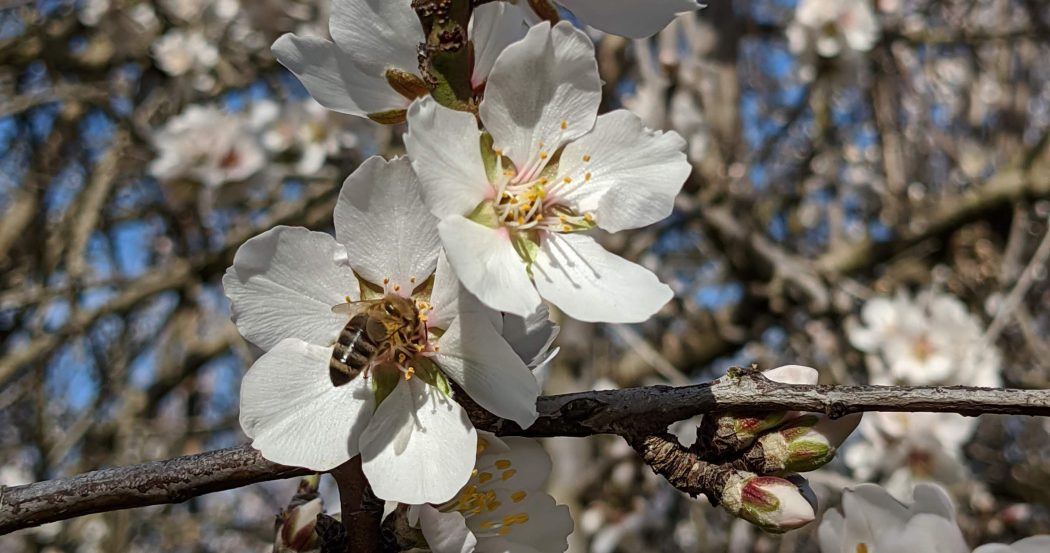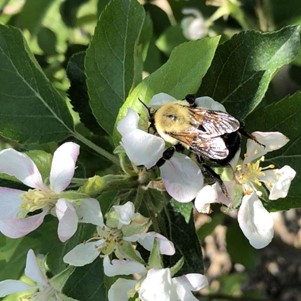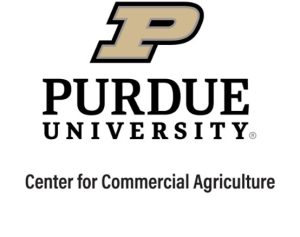The UC Davis Series
By: Elina L. Niño
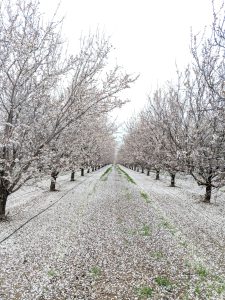
Almond orchard at petal fall.
As I’m writing this in early February, the first almond blooms are starting to pop in the orchards throughout San Joaquin Valley. This makes it only appropriate to kick off this article with a discussion of our work in almond pollination. Then we will venture to talk a little about the dreaded pesticides and continue with an equally somber discussion of the impact of climate change on honey bee health, and wrap up with a mention of a bee sampling technique veterinarians can use for histological analysis of honey bee health. All I can say is there is never a dull moment in the lab!
Almond Pollination Requirements
There are several important predictors of almond nut yield such as the age of production trees, tree density, temperature, light interception, management approaches, etc. In addition, we all know that almond production in California is highly dependent on successful pollination by honey bees. Almond growers have been renting honey bee colonies for decades in order to ensure pollination of their orchards, thereby guaranteeing optimal production (providing, of course, everything else aligns). The University of California recommendation for stocking a one-acre mature, nut-bearing orchard is two to 2.5 hives, with an average strength of eight frames per hive. The cost for renting a colony has been sitting at about $180-220/hive for a few years now, and with California having approximately 1.4 million nut bearing acres, you do the math.
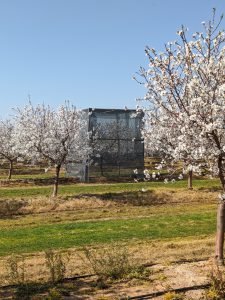
Caged almond tree during the bee exclusion experiments (Photo by E. L. Niño)
This, along with continued reports of colony losses, has caused concern in almond growers over having access to sufficient bee supply and increasing costs of hive rentals. In hopes of reducing reliance on bee pollination, growers slowly began adopting new self-fertile almond varieties such as Independence®, Shasta®, Pyrenees®, Yorizane and a few others. These varieties do not require a pollinizer like the conventional varieties, and therefore the thought is that these varieties would do very well without the presence of pollinating bees. In fact, what got me interested in conducting research on pollination needs of self-fertile almond varieties were very bold titles of many online articles that bees are no longer needed (my favorite remains: “Some almond trees don’t need to stinkin’ bees! – neogen.com) despite the obvious lack of data supporting this assumption. Prior study (see https://www.nature.com/articles/s41598-020-59995-0) found that Independence trees in absence of bees had significantly lower nut set and yield. In 2020-2023, my collaborators (Dr. Arathi Seshadri, USDA-ARS; Dr. Angelita De la Luz, Beeflow, Inc.; Zac Ellis, OFI) and I continued to address the question of bee pollination needs of Independence® and Shasta® varieties, and expand to address specific pollination parameters such as number of bee visits, nut quality and determination of optimal stocking rates.
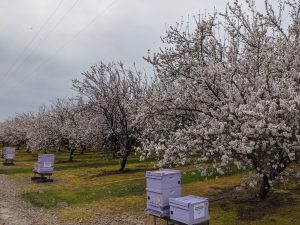
Honey bee research colonies used for evaluation of supplemental forage in almond orchards (Photo by E. L. Niño)
Our comprehensive research utilizing bee exclusion experiments provides substantial evidence that the presence of honey bees during the bloom period significantly enhances both the final nut set and the overall yield of the two almond varieties under study. This enhancement occurs without any discernible negative impact on the quality of the Independence® almond nuts, however, we did record that the kernel mass was lower when trees were exposed to bee visitation. This is likely due to resource distribution, when bee-visited trees set higher number of fruits per tree, the tree has fewer resources to allocate to individual kernels leading to lower mass. This suggests that even varieties that can self-pollinate benefit from the presence of bees, possibly due to more efficient pollination. In 2021, we also addressed the impact of hive stocking rates on bee visitation numbers, presumably driving yield. When we compared orchards stocked with one or two hives per acre, there was no apparent benefit from supplying an extra hive per acre. It is worth noting that there was ambient presence of bees in the no-hive treatment, but there was a marked increased in bee visitation rates when the stocking rate was at one hive per acre. Our economic analysis underscores advantages of renting bees for use in self-fertile almond orchards, a practice that could potentially increase profitability for almond growers. At the time of my writing, the manuscript outlining our research thus far has been submitted for peer review and if you want to learn more, I invite you to read the pre-print of our manuscript at Research Square https://www.researchsquare.com/article/rs-3870916/v1. Just keep in mind that the study at the time of your reading might still be under peer-review. However, I can’t complete this paragraph without telling you perhaps the best thing about this study. My collaborators and I actually conducted our studies independently in two separate years and didn’t know about it until we met up at a conference the following year. It was an event that every researcher dreams about – to have their work validated independently by another scientist without any prompting. Needless to say we were more than excited.
As we move forward, our research will focus on refining the optimal stocking rates for both self-fertile and conventional almond varieties. The outcomes of this research could provide valuable insights that will help alleviate the challenges faced by both almond growers and beekeepers. These challenges include optimization of the best practices for bee management in almond orchards, optimizing the use of bees for pollination and ensuring the health and survival of bee populations. By addressing these issues, our research could contribute to the sustainability and profitability of both the beekeeping and the almond industry.
Evaluating Potential Risks and Benefits in California Agricultural Lands
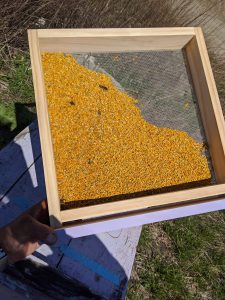
Pollen collected by sentinel hives and analyzed for plants visited and pesticides present.
When foragers go out to collect beneficial food sources (and pollinate plants in the process) sometimes they encounter potentially risky composites such as pesticides, which can negatively impact colony health and survival. Additionally, research suggests that these negative impacts can be alleviated by ensuring the bees have access to proper nutrition further highlighting the importance of habitat management for healthy bee populations. To evaluate the level of risk that the bees are exposed to, particularly in California’s agricultural landscapes, my lab collaborated with Dr. Neal Williams (UC Davis), Dr. Eric Lonsdorf (Emory University) and Dr. Arathi Seshadri (USDA-ARS Bee Lab). We utilized the Pesticide Use Reporting database provided by the California Department of Pesticide Regulation to assess the predictive pesticide risk in three counties. Based on these data, we then selected 20 different locations to represent a gradient of environmental conditions and potential exposure to pesticides. We placed three sentinel honey bee hives at each of the locations and we closely monitored colonies for various strength and health parameters, providing us with valuable data on bee health. Over time, we collected pollen that the foragers were bringing back from the local environment and have analyzed it to determine the plant composition within the landscape and the actual pesticides brought into the hive by foraging bees. This data is currently being analyzed and we anticipate that the results will be instrumental in informing management decisions of agriculture stakeholders. In addition, Dr. Williams and his team have been utilizing some of this information to develop a predictive model of bee pesticide exposure. This model integrates an already developed pollinator foraging model, pesticide use data from CDPR and pesticide information collected from our sentinel hives. You will be able to learn in more details about this particular project from Dr. Williams himself in an upcoming issue of Bee Culture. By understanding the risks and benefits of different landscapes in which bees exist, beekeepers, land managers and growers can make more informed, predictive decisions that support bee health and productivity.
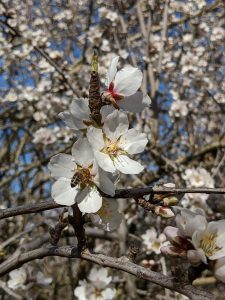
Honey bee visiting almond flower.
While it is great to parse out what are the stressors or combinations of stressors that might impact the bees, I always want to know if we as researchers can be even more proactive in protecting pollinators. This is why in collaboration with Dr. Florent Trouillas and Dr. Rachel Vannette (UC Davis) we set out to identify novel microorganisms for biocontrol of fungal diseases in almonds, thereby potentially reducing exposure of bees to possibly harmful synthetic pesticides. We have been successful in identifying several possible microorganisms which had efficacy against the causative agent of brown rot in almonds, and seemingly no negative impact on bees (read the full article here https://apsjournals.apsnet.org/doi/full/10.1094/PDIS-03-21-0549-RE). What really triggered this project was my interest in apivectoring. This term simply means that the bees are used as vectors or delivery agents of biocontrol microorganisms to various crops during pollination for control of various diseases or even pests. The idea is that the bee picks up the biopesticide while exiting the hive and drops it off while visiting various flowers. This methodology has been used with bumblebees in a number of different crops and it seems that almonds could be the next frontier. It has the potential to reduce grower costs for pest management by reducing labor and possibly even increasing the coverage all the while being less risky for bees. It could benefit the sustainability and profitability of the almond industry, while also supporting the health and survival of bee populations.
Impact of Climate Change-Driven Air Pollution
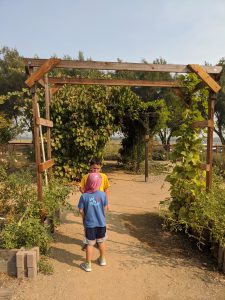
Visitors to the UC Davis Bee Haven garden. The orange tint of the photo is due to the heavy air pollution from California wildfires.
Even with the increased concerns about the climate change impact on all life, there is fairly little known about the impacts of climate change on honey bee health in particular. The occurrence of particularly severe wildfires in California in the past decade or so has caused losses to beekeepers who had hundreds of colonies burn down in the fires. While the devastation is obvious when the colonies burn down, the bigger question is what are the impacts of the resultant air pollution on surviving colonies. Together with my USDA collaborators (A. Seshadri and C. Mayack) we followed colonies strategically placed in areas in California historically prone to wildfires. During the wildfire season, we recorded air quality, colony strength and health parameters, and processed samples for presence of pathogens and immune responsiveness. Perhaps expectedly, our data indicate that poor air quality is associated with higher maximum daily temperatures, lower expression of prophenoloxidase (immune gene) and higher vitellogenin (gene associated with longevity) expression resulting from higher oxidative stress. There was also an indication that varroa mite infestation decreases heat shock protein gene expression, suggesting the limited ability of mite-infested colonies to buffer against extreme temperatures. To learn more about our findings visit https://www.ncbi.nlm.nih.gov/pmc/articles/PMC10455886/. We plan to continue documenting the indirect impacts of poor air quality on colony health so we can better equip beekeepers with tools to buffer against climate change effects.
Sampling Protocol for Histological Evaluation
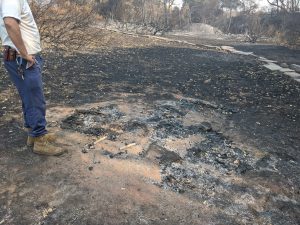
Remnants of two hives burned in a California wildfire in 2020. Only metal components remain.
I wanted to finish this article on a more positive note so I’ll tell you about a fun study which helped us develop a detailed sampling protocol for using honey bees for histological analysis in veterinary diagnostics. When the Food and Drug Administration came out with the new rule stating that the veterinarians are to diagnose honey bee diseases and prescribe antibiotics, I think I could hear a light collective panic of the veterinary medical community. Honey bees and apiculture might be traditionally associated with veterinarians and veterinary colleges across the world, but that is not the case in the U.S. and veterinarians do not get any beekeeping training during their formal education. This however, invited some great new opportunities for collaborations with the veterinary medical community (S. Cook, UC Davis School of Veterinary Medicine) and resulted in several great outcomes. One of them being the publication describing the optimal protocol for honey bee field sample collection for histological analysis. In this study, we developed and tested several field protocols for the sampling of honey bees and then compared the tissue quality to ensure no to minimal damage. Our results suggest that the common formalin fixation is sufficient for subsequent histological analysis, and using dry ice to immobilize bees in the field (as it is commonly done in research and sample collecting) does not negatively impact the tissue quality. To learn more visit https://journals.sagepub.com/doi/10.1177/10406
387231191732.
The second outcome was the development of the online “Honey bees and beekeeping” course for veterinarians (https://beevets.wifsslearning.com/) in collaboration with UC Davis Western Institute for Food Safety & Security and Dr. Ramesh Sagili (Oregon State University). The course has been certified by the American Association of Veterinary State Boards which veterinarians can complete for Continued Education credits. Supporting veterinarians in providing necessary services to the beekeeping communities will ensure that beekeepers minimize pathogen spread and therefore support colony health. If you are a veterinarian interested in providing services for beekeepers or just want to learn more, I encourage you to take the course and please feel free to contact me with any questions.
I am very grateful to our funders as the work would not have been possible without their support: Almond Board of California, California State Beekeepers Association, California Department of Pesticide Regulation, USDA-SCRI, USDA-ARS, University of California Davis and Project Apis m. And lastly, I want to acknowledge all of the past and current members of the E. L. Niño Bee Lab as they are the real driving force behind all of our accomplishments. Please make sure to visit our websites (see below) to learn more about the team and many other exciting things that we are involved in. And don’t forget to read more about it in the upcoming issues!
Disclaimer: Mention of any products and companies does not constitute an endorsement.
E. L. Niño Bee Lab: https://elninobeelab.ucdavis.edu/
California Master Beekeeper Program: https://cambp.ucdavis.edu/
UC Davis Bee Health Hub: https://beehealthhub.ucdavis.edu/




